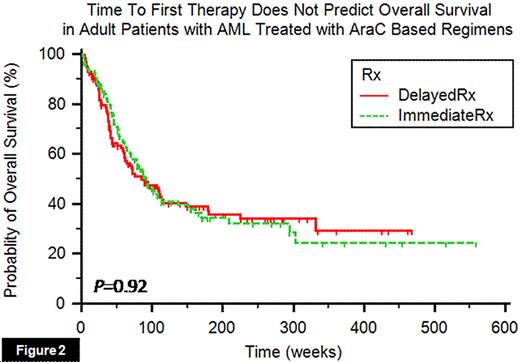Abstract
Abstract 1617
Poster Board I-643
A rapid decline of circulating blasts in response to induction therapy is one of the most important prognostic factors of clinical outcome in childhood acute lymphoblastic leukemia. However, the prognostic significance of time to blast clearance in adult AML has not been well-established. The Mayo Clinic recently reported improved OS with early clearance ('3 days) of peripheral blood (PB) blasts among 86 adult patients with AML. In a separate series, age is suggested to modify the effect of time with shorter interval from diagnosis to induction therapy (TDT) predicting improved OS in younger but not older AML patients. We retrospectively reviewed the Stanford Leukemia Database to validate the prognostic relevance of time and age as a putative effect modifier with respect to OS in AML.
From 1993 to 2008 outcomes of 1,909 adult patients with leukemia were reviewed to select eligible patients with previously untreated AML (non-acute promyelocytic leukemia) having received cytarabine-based induction regimens. We defined the day of PB blast clearance (the first day after initiating induction chemotherapy that PB blasts were absent), and three “blast risk groups” (good, intermediate and poor, according to PB blast clearance on or before day 3, on days 4 or 5, or on day 6 or beyond, respectively) identical to the Mayo Clinic model. A 100 cell manual slide differential count was evaluated from the first day of induction through nadir with PB blasts enumerated unless the WBC was less than 0.5 ×109/L. For purposes of TDT analysis, patients receiving therapy on day of diagnosis were excluded (24 patients) as performed in the Cleveland Clinic-MD Anderson (CC-MDA) model. We defined delayed versus immediate treatment (delayed meaning more than 5 days from day of diagnosis to first day of induction therapy) identical to the CC-MDA model.
Among 333 patients (55% males; median age 53y, range 18-88, including 224 patients<60y) with previously untreated AML, the median and range of white blood cell count (WBC), PB blast percent, and TDT were 10 × 109/L (range: 0.1–332), 23.0% (range: 0–98), and 4 days (range: 0-91) respectively. Karyotype was classified as favorable, intermediate and unfavorable in 9.7%, 59.3% and 31% of cases, respectively. At the time of analysis, 56% had died, primarily of relapse. Median OS was 59 weeks (range: 0-558) in all patients, 76.2 (range: 3.4-558) and 38.3 (range: 0-342) weeks in patients younger than 60 years, and older patients, respectively. The median time to PB blast clearance was six days (range: 1– >11). The distribution of good, intermediate and poor blast risk groups was 28.3%, 26.1%, and 45.6%, without significantly different median OS of 63.8, 56.2, and 51.6 weeks, respectively (Fig 1, p=0.61). In univariate analysis there was no relationship between TDT and OS among all patients as a continuous variable (p=0.791) or classified as delayed versus immediate treatment (Fig 2, p=0.92). When stratified by older and younger AML patients, age did not modify the effect.
In adults with non-APL AML, both TDT and PB blast clearance after induction chemotherapy with cytarabine-based regimens failed to predict OS. Current practice standards should not be modified until further studies validate the significance of time from diagnosis to treatment and to clearance of circulating blasts.
No relevant conflicts of interest to declare.
Author notes
Asterisk with author names denotes non-ASH members.



